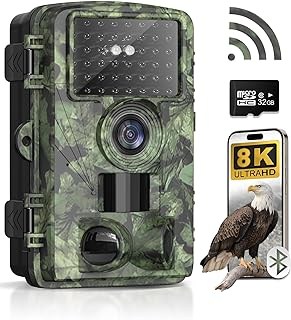5 important factors worth considering when looking for the best outdoor wildlife camera
Choosing the right outdoor wildlife camera is important for anyone who loves nature and animals. There are many options available, from trail cameras to DSLRs, each with different features. However, it’s not just about specs and price. Factors like durability, weather resistance, image quality, and battery life are crucial for outdoor wildlife photography. Making a well-informed decision based on these factors is the first step to a great wildlife photography adventure.
See our guide to the best outdoor wildlife camera.
Resolution
When choosing an outdoor wildlife camera, resolution is a key feature that greatly affects the quality of your pictures and videos. Higher resolution provides sharper images and a clearer view of wildlife in their natural habitat. A superior resolution can make your wildlife photography and videos more vibrant and detailed, creating an immersive experience for both hobbyists and professionals. Investing in a camera with great resolution enhances your outdoor adventures, allowing you to vividly remember those amazing moments with clarity.
Additionally, a high-resolution wildlife camera opens up new opportunities for wildlife enthusiasts to zoom in, crop, and enhance their images without losing quality. The finer details captured through superior resolution can reveal hidden wonders of the natural world, forming a deeper connection with wildlife and their environment. Ultimately, resolution is the key to unlocking the beauty and complexities of outdoor wildlife, empowering photographers to explore, discover, and share their love for the wilderness with authenticity and visual appeal.
Battery life
Choosing an outdoor wildlife camera is important, but don’t forget to consider battery life. It’s crucial for the camera to last a long time in the wild without needing constant battery changes. Having a camera with a long-lasting battery can mean the difference between missing a rare wildlife moment and capturing it forever. Imagine setting up your camera in a great spot, only for it to die a few hours later, leaving you clueless about the animals around. Getting a camera known for its excellent battery life is like investing in unforgettable nature photos.
Having a strong battery life doesn’t just mean you can cover wildlife areas for longer, but it also gives you peace of mind on outdoor trips. No wildlife enthusiast wants to worry about their camera dying instead of enjoying nature. If you choose a camera with a good battery life, you can focus on watching animals without stressing about the battery. In wildlife photography, where patience is crucial, a reliable camera battery is like a quiet friend, always ready to capture the wild’s beauty.
Trigger speed
Choosing an outdoor wildlife camera with a fast trigger speed is important for capturing fleeting moments in nature. A quick trigger speed means the camera takes pictures as soon as it senses motion, reducing the risk of missing a great shot. In wildlife photography, time is precious, so having a camera that reacts fast can help you get better quality and more diverse images.
On the other hand, a slow trigger speed can lead to blurry or missed photos, which can be frustrating. By investing in a camera with a fast trigger speed, you increase your chances of getting clear, detailed images and make your photography experience more enjoyable. Whether you’re trying to capture a fast-running deer or a majestic eagle in flight, a camera with a swift trigger speed can turn an average photo into a stunning piece of wildlife art.
Infrared technology
When choosing an outdoor wildlife camera, it’s important to consider adding infrared technology. Infrared technology helps capture clear images and videos in low-light settings, making it ideal for observing wildlife at night without disrupting them. The discreet nature of infrared light allows for natural behavior to be captured without the animals noticing your presence.
Using infrared technology not only benefits us as observers, but also helps protect the well-being of the wildlife we’re studying. By minimizing disturbances during nighttime monitoring, we can help conserve these species and their habitats. Infrared sensors provide a non-invasive way to study wildlife behavior without causing stress or interference.
Investing in outdoor wildlife cameras with infrared technology isn’t just a choice, but a responsibility to help protect the ecosystems we admire and seek to conserve.
Weather resistance
When buying an outdoor wildlife camera, it’s important to consider how well it can handle different weather conditions. The durability and performance of the camera depend on its ability to withstand the elements. A camera made with strong, weather-resistant materials will last longer and give wildlife enthusiasts peace of mind when using it outside. Cameras that aren’t weather-resistant can get damaged by rain, snow, and extreme temperatures, leading to malfunctions and potentially missing out on capturing important wildlife moments. Prioritizing weather resistance is essential for a better outdoor wildlife photography experience.
Additionally, choosing a weather-resistant camera is not just about protecting it, but also about reducing electronic waste by avoiding the need to frequently replace damaged equipment. Opting for cameras that can handle various weather conditions reflects a sustainable approach to photography that respects and works with nature. By including weather-resistant features in outdoor wildlife cameras, photographers are making a conscious decision to prioritize durability, reliability, and environmental responsibility when capturing the natural beauty of the world.
Conclusion
The outdoor wildlife camera is more than just a gadget – it allows us to peek into the fascinating world of nature. It captures beautiful moments and lets us see wild animals in their natural homes. As we explore the wilderness through the camera’s lens, we learn more about the ecosystem and feel a strong connection to it. Each photo we take reminds us of the complex web of life around us and our role in this amazing world.
